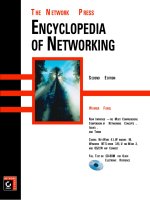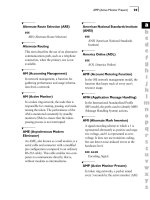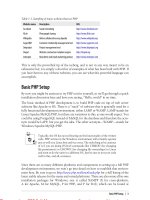Encyclopedia of Networking P2
Bạn đang xem bản rút gọn của tài liệu. Xem và tải ngay bản đầy đủ của tài liệu tại đây (511.93 KB, 10 trang )
AMP (Active Monitor Present) 29
a
b
c
d
e
f
g
h
i
j
k
l
m
n
o
p
q
r
s
t
u
v
w
x
y
z
▼
Alternate Route Selection (ARS)
SEE
ARS (Alternate Route Selection)
▼
Alternate Routing
This term describes the use of an alternative
communications path, such as a telephone
connection, when the primary one is not
available.
▼
AM (Accounting Management)
In network management, a function for
gathering performance and usage informa-
tion from a network.
▼
AM (Active Monitor)
In a token ring network, the node that is
responsible for creating, passing, and main-
taining the token. The performance of the
AM is monitored constantly by standby
monitors (SMs) to ensure that the token-
passing process is not interrupted.
▼
AME (Asynchronous Modem
Eliminator)
An AME, also known as a null modem, is a
serial cable and connector with a modified
pin configuration (compared to an ordinary
RS-232 cable). This cable enables two com-
puters to communicate directly; that is,
without modems as intermediaries.
▼
American National Standards Institute
(ANSI)
SEE
ANSI (American National Standards
Institute)
▼
America Online (AOL)
SEE
AOL (America Online)
▼
AMF (Account Metering Function)
In the OSI network management model, the
function that keeps track of every user’s
resource usage.
▼
AMH (Application Message Handling)
In the International Standardized Profile
(ISP) model, the prefix used to identify MHS
(Message Handling System) actions.
▼
AMI (Alternate Mark Inversion)
A signal-encoding scheme in which a 1 is
represented alternately as positive and nega-
tive voltage, and 0 is represented as zero
voltage. It does not use transition coding,
but can detect noise-induced errors at the
hardware level.
SEE ALSO
Encoding, Signal
▼
AMP (Active Monitor Present)
In token ring networks, a packet issued
every 3 seconds by the active monitor (AM)
30 Amplifier
on the ring to indicate that the AM is work-
ing and is still in charge.
▼
Amplifier
A device for boosting an analog signal. The
same service is provided by a repeater for
digital signals.
▼
Amplitude
The magnitude, or level, of a signal. For
an electrical signal, it is expressed in volts
(voltage) or amperes (current). In computer
contexts, current is more likely to be
expressed in milliamperes.
▼
AMPS (Advanced Mobile Phone
Service)
A cellular telephone service. AMPS is a wire-
less analog communications service that
operates in the 825 to 890 megahertz range.
▼
Analog Communication
A telecommunications system that uses
analog (that is, continuous, sinusoidal)
signals to represent information. An exam-
ple of an analog communication system is
the classic voice-based telephone system
(which is being replaced by the newer, digital
systems).
▼
Analog Intensity Modulation (AIM)
SEE
AIM (Analog Intensity Modulation)
▼
Analog-to-Digital Conversion
The process of converting an analog signal
(one that can take on any value within a
specified range) to digital form. An analog-
to-digital converter (ADC) is a device that
converts an analog signal to digital form.
▼
ANF (AppleTalk Networking Forum)
A consortium of developers and vendors
working to encapsulate AppleTalk in other
protocols; for example, within the TCP/IP
suite.
▼
ANI (Automatic Number
Identification)
In ISDN and some other telecommunica-
tions environments, a feature that includes
the sender’s identification number, such as
telephone number, in the transmission, so
that the recipient knows who is calling; also
known as caller ID.
▼
Annex D
In frame-relay technology, a document that
specifies a method for indicating permanent
virtual circuit (PVC) status. The document is
part of the ANSI T1.617 standard.
▼
Anonymous FTP
On the Internet, a protocol that allows a
user to retrieve publicly available files from
other networks. By using the special user ID,
“anonymous” users can transfer files with-
out a password or other login credentials.
(FTP is an application-layer protocol in the
Internet’s TCP/IP protocol suite.)
Anti-Virus Program 31
a
b
c
d
e
f
g
h
i
j
k
l
m
n
o
p
q
r
s
t
u
v
w
x
y
z
▼
Anonymous Remailer
An Internet service that can be used to hide
the origins of an e-mail message being sent
to someone. The anonymous remailer
removes any source address information
from a message, substitutes any specified
pen name, and then sends the message on
to the specified destination.
▼
ANSI (American National Standards
Institute)
The United States representative in the ISO
(International Standardization Organiza-
tion). ANSI creates and publishes standards
for programming languages, communica-
tions, and networking. For example, the
standard for the FDDI network architecture
is ANSI X3T9.5.
▼
Anti-Virus Program
An anti-virus program is used for detecting
or removing a computer virus. An anti-virus
program looks for suspicious activity, such
as unnecessary disk access, attempts to inter-
cept a BIOS or other low-level call, and
attempts to format or delete files. In some
cases, the anti-virus program detects a pat-
tern characteristic of a particular virus.
Some anti-virus programs are TSR
(terminate-and-stay-resident) programs,
which monitor computer activity constantly,
looking for indications of a virus. In some
cases, these types of programs can be
extremely annoying and very processor
intensive. Users have been known to remove
an anti-virus TSR program from memory
out of frustration.
Other anti-virus programs are intended to
be run periodically. When they are run, the
programs look for the tell-tale signs (known
as signatures) of particular viruses. These
programs are minimally disruptive; on the
other hand, their effectiveness is directly
proportional to the frequency with which
they are used.
Because the coding for computer viruses
is constantly changing, anti-virus programs
must also be updated regularly. It is impor-
tant to test anti-virus programs thoroughly,
which means that every new release must be
tested. Make sure an anti-virus program per-
forms to your expectations before installing
it on a network. Some programs can eat up
a significant amount of working memory.
Recently, a very different (and, conse-
quently, very controversial) type of anti-
virus program has become available. InVirc-
ible, created by Zvi Netiv, is designed to
detect viruses that have already infected a
system, and to clean these up. Rather than
looking for virus signatures, InVircible uses
expert system rules to look for behavior
characteristic of viruses: replication, use of
memory, attempts to attach to the anti-virus
program, etc. InVircible will even put out
“virus bait” to get an existing virus to try to
infect the bait.
BROADER CATEGORY
Data Protection
RELATED ARTICLE
Virus
32 AOL (America Online)
▼
AOL (America Online)
America Online is a commercial online ser-
vice like CompuServe and Prodigy. AOL
supports both DOS and Windows users, and
provides a range of services (mail, news, ref-
erence, financial, entertainment, Internet
access, etc.). Users pay a flat monthly fee,
which allows a limited number of free hours.
Additional hours are billed at a predeter-
mined rate. AOL’s graphical interface is
highly regarded—in fact, Apple has licensed
the interface technology for use in Apple’s
eWorld interface. AOL provides a very com-
prehensive set of access opportunities to the
Internet.
FOR INFORMATION
Call AOL at 800-827-6364
▼
AOM (Application OSI Management)
In the International Standardized Profile
(ISP) model, the prefix for functions and
services related to network management.
▼
AOW (Asia and Oceania Workshop)
One of three regional workshops for imple-
menters of the OSI Reference Model. The
other two are EWOC (European Workshop
for Open Systems) and OIW (OSI Imple-
menters Workshop).
▼
AP (Application Process)
In the OSI Reference Model, a program that
can make use of application layer services.
Application service elements (ASEs) provide
the requested services for the AP.
▼
APD (Avalanche Photodiode)
A detector component in some fiber-optic
receivers. The APD converts light into elec-
trical energy. The “avalanche” refers to the
fact that the detector emits multiple elec-
trons for each incoming photon (light
particle).
▼
APDU (Application Protocol Data
Unit)
A data packet at the application layer; also
called application-layer PDU.
SEE ALSO
OSI Reference Model
▼
API (Application Program Interface)
An abstract interface to the services and pro-
tocols offered by an operating system, usu-
ally involving a published set of function
calls. Programmers and applications can
use the functions available in this interface
to gain access to the operating system’s
services.
▼
APIA (Application Program Interface
Association)
A group that writes APIs for the CCITT’s
X.400 Message Handling System (MHS).
▼
APPC (Advanced Program-to-
Program Communications)
In IBM’s SAA (Systems Application Archi-
tecture), APPC is a collection of protocols
to enable executing applications to commu-
nicate directly with each other as peers
(without intervention by a mainframe host).
AppleTalk 33
a
b
c
d
e
f
g
h
i
j
k
l
m
n
o
p
q
r
s
t
u
v
w
x
y
z
APPC is defined at a level comparable
to the session layer in the OSI Reference
Model. It can be supported in various net-
working environments, including IBM’s
SNA (System Network Architecture),
Ethernet, Token Ring, and X.25.
APPC/PC (Advanced Program-to-
Program Communications/Personal Com-
puters) is a PC-based version of APPC.
▼
AppleDouble
In the Macintosh world, a file format that
uses separate files for the data and resource
forks that make up a Macintosh file. This
enables the files—or at least the data por-
tion—to be used on different platforms.
COMPARE
AppleSingle
▼
AppleShare
A network operating system from Apple.
AppleShare runs on a Macintosh network
server, providing file and printer services.
AppleShare uses the AppleTalk protocol
suite to carry out its tasks.
SEE ALSO
AppleTalk
▼
AppleSingle
In the Macintosh world, a file format that
stores both a file’s contents (data fork) and
its resources (resource fork) within a single
file. Because data and resources are mixed in
a proprietary format, such a file cannot be
used on other platforms.
COMPARE
AppleDouble
▼
AppleTalk
AppleTalk is Apple’s proprietary protocol
suite for Macintosh network communica-
tions. It provides a multilayer, peer-to-peer
architecture that uses services built into the
operating system. This gives every Macin-
tosh networking capabilities. AppleTalk can
run under any of several network operating
systems, including Apple’s AppleShare,
Novell’s NetWare for Macintosh, and Sun
Microsystems’ TOPS.
AppleTalk was developed in the mid-
1980s with the goal of providing a simple,
portable, easy-to-use, and open networking
environment. To access such a network,
a user just needs to “plug in, log in, and
join in.”
A newer version, Phase 2, was released in
1989. This version provided some new capa-
bilities and extended others.
AppleTalk is a comprehensive, layered envi-
ronment. It covers networking services over
almost the entire range of layers specified in
the OSI Reference Model. The figure “The
AppleTalk protocol hierarchy” shows the
organization of the AppleTalk layers, as well
as the protocols in the AppleTalk Protocol
Suite.
AppleTalk Layers









